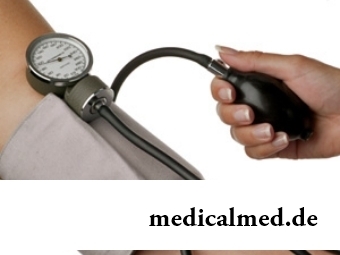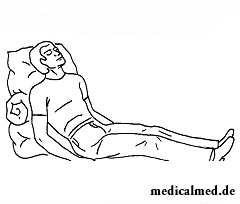





First aid at hypertensive crisis
Hypertensive crisis – the acute state which is characterized by sharp rise in the arterial pressure (AP), posing direct threat to life. Therefore it is important to know signs of this state and to be able to give first aid at hypertensive crisis.
It is normal of value of an indicator of the ABP also at crisis
 In spite of the fact that raising of the ABP is also the reason of hypertensive crisis, there is no accurate quantitative index of the ABP which would indicate that the events hypertensive crisis, but not something other. For this reason doctors recommend to patients to know with cardiovascular and renal pathology (namely such patients first of all enter into risk group) the, so-called, working pressure – indicators of the ABP which correspond to their normal health in lack of an emotional and exercise stress.
In spite of the fact that raising of the ABP is also the reason of hypertensive crisis, there is no accurate quantitative index of the ABP which would indicate that the events hypertensive crisis, but not something other. For this reason doctors recommend to patients to know with cardiovascular and renal pathology (namely such patients first of all enter into risk group) the, so-called, working pressure – indicators of the ABP which correspond to their normal health in lack of an emotional and exercise stress.
This parameter at people can differ as the norm of the ABP fluctuates in quite considerable limits – from 110 to 140 mm Hg for a systolic (upper) indicator, and from 60 to 90 mm Hg for diastolic (lower). For most of the people who do not have a hypertension norm is the indicator of the systolic pressure of 110 mm Hg, respectively, increase in pressure even to 120 mm Hg can testify to pathology while for the person inclined to a hypertension, the indicator in 140 mm Hg can be norm.
If the patient knows the working pressure, then, making a start from it, it is possible to define the state which is hypertensive crisis or menacing to them to become. For example, if to usual health of the person there corresponds pressure of 110/70 mm Hg, then the indicator in 120/80 will already indicate a hypertension.
It must be kept in mind that not each person with hypertensive crisis knows the working pressure, the victim cannot sometimes give the correct answer during the occurring crisis because of feeling sick, but also, not always the tonometer is had near at hand to measure the ABP. Therefore for first-aid treatment it is necessary to know also other symptoms of hypertensive crisis.
Symptoms of hypertensive crisis
Symptoms of hypertensive crisis are:
- The sharp or amplifying headache, it is especially frequent in occipital area;
- Feeling of squeezing of the head;
- Feeling of a pulsation of blood in temples;
- Reddening or on the contrary, blanching of integuments;
- Ring in ears;
- Eye pain, "front sights" before eyes, deterioration in sight;
- Emergence of an asthma, pain behind a breast and tachycardia (cardiopalmus) is possible;
- Nausea, is possible vomiting;
- Acrimony, sharp reaction to bright light, loud sounds and other activators.
Hypertensive crisis can sharply develop, and can gradually, with slow increase of symptoms. The first type of crisis is called hyperkinetic, it is inherent to people at early stages of a hypertension. Not too high rates of the ABP are characteristic of this type, in addition to the acute beginning. The second type is called hypokinetic, as a rule, it happens at the people long ago having a hypertension, the ABP at the same time raises considerably, and symptoms of crisis can remain from several hours to several days. Both types can lead to effects extremely hazardous to health, up to a lethal outcome.
First-aid treatment at hypertensive crisis
The first that needs to be made at suspicion of hypertensive crisis, it to call the ambulance. The before people will receive the qualified help, rather it will be possible to stop an attack and the less risk of development of heavy complications of crisis.
In this rule there is an exception. Many patients, it is long having a hypertension, are already able to stop crisis, distinguishing its approach on the first symptoms and taking necessary medicine on the algorithm made by the attending physician. In this case, having accepted necessary drugs, the person has to remain all the same under observation, and having only convinced that drugs worked, and the condition of the victim improves, it is possible to refuse a call of acute management. Nevertheless, it is necessary to inform on the event of the attending physician in the nearest future.
In all other cases waiting for arrival of ambulance it is necessary to do the following:
- To lay the patient with the raised head. If the headache in a prone position amplifies, it is possible to reach a comfortable sitting position;
- To provide to the patient absolute rest, both physical, and emotional;
- To provide inflow of fresh air: to open a window, to weaken close clothes;
- If circumstances allow, to carry out the procedures directed to blood outflow: to put cold to the head, to apply mustard plasters to a collar zone, gastrocnemius muscles. It is possible to make a hot foot tray.
 Giving first aid at hypertensive crisis it is important to remember that, despite an intensive headache, the patient before arrival of ambulance should not give any drugs "from the head", "from heart", etc. which by accident were available and in operation which you are not sure. The anesthetizing drugs are undesirable as they complicate the subsequent diagnosis, without removing the crisis causes. But even if it is known that the drug which accidentally appeared near at hand possesses anti-hypertensive (lowering pressure) action, it must be kept in mind - in such situation the doctor as too sharp decrease in the ABP at hypertensive crisis can also lead to serious consequences has to appoint and control drug treatment.
Giving first aid at hypertensive crisis it is important to remember that, despite an intensive headache, the patient before arrival of ambulance should not give any drugs "from the head", "from heart", etc. which by accident were available and in operation which you are not sure. The anesthetizing drugs are undesirable as they complicate the subsequent diagnosis, without removing the crisis causes. But even if it is known that the drug which accidentally appeared near at hand possesses anti-hypertensive (lowering pressure) action, it must be kept in mind - in such situation the doctor as too sharp decrease in the ABP at hypertensive crisis can also lead to serious consequences has to appoint and control drug treatment.
If to smile all twice a day – it is possible to lower blood pressure and to reduce risk of developing of heart attacks and strokes.

Urogenital candidiasis (milkwoman) – a fungal infection which annoys unpleasant feelings in the field of generative organs, сопр...
Section: Articles about health
Scientists always aimed to offer fundamental explanations for medical problems. Their theories formed the basis of modern methods of treatment of the hardest pathologies and helped to save a set of lives. However stories are known also such theoretical constructions, following to...
Section: Articles about health
People know that thermal sources have salutary force long ago. Treatment by natural waters is one of the most ancient methods of disposal of the most different diseases. Bathtubs, souls, wrappings and inhalations, in combination with water reception inside help to improve a condition of the patients suffering from disturbances of work of a musculoskeletal system, bodies of digestive tract, cardiovascular, nervous, respiratory and secretory system, skin and endocrine п...
Section: Articles about health
The immunity role in growth of the child is invaluable. The proteins-immunoglobulins produced by immune system preserve the child against diseases...
Section: Articles about health
Nightmares belong to the most unpleasant frustration. Statistically, they happen at 4% of adults, and almost at 70% of children and teenagers. During a nightmare of people dreams himself in extremely difficult, life-threatening situation. It wakens suddenly, in...
Section: Articles about health
Each person has easy indispositions which he transfers "standing", trying not to ask for medical care. Arguments at the same time are adduced same: "it is a trifle, itself will pass", "I have too many important issues", "there are no wish to spend time for doctors", etc. At good shape of health, normal working capacity and lack of suspiciousness dislike for complaints to such problems is quite natural. It is not the most correct, but very widespread type of behavior. I am glad...
Section: Articles about health
For many women the word "fat" sounds as a sentence. In aspiration to an ideal figure they try to exclude, first of all, from with...
Section: Articles about health
The concept "gluten" (differently, a gluten) combines group of the proteins which are a part of rye, barley and wheat. For most of people the use of the food stuffs containing a gluten not only is safe, but also it is very useful. Nevertheless, there is a number the myth...
Section: Articles about health
Physical activity is necessary for normal functioning of a human body. At a lack of the movement joints cease to function, muscles atrophy, cardiovascular activity is broken and the metabolism worsens. The modern city rhythm of life does not provide the person with an adequate exercise stress, additional - sport is necessary. Tedious tasks the huge number of the people having those or ин exists sport not all to liking, but also...
Section: Articles about health
Traveling all over the world, many try to try the most exotic dishes of national cuisines. Exists even so-called died away...
Section: Articles about health
The main role in development of a peptic ulcer of a stomach and duodenum the bacterium Helikobakter plays pilor. Activity and the strengthened reproduction of this microorganism lead to weakening of protection of mucous membranes and their erosive damage. Manifestations not...
Section: Articles about health
The unpleasant feelings connected with spring breakdown are familiar almost to each of us. Often happens that in March-April on the person weakness leans: he suffers from drowsiness, complains of bad mood, loss of interest in life and failures in affairs....
Section: Articles about health
Not without reason doctors say that 90% of diseases begin or develop because of misoperation of intestines. Disturbance of its functions связ...
Section: Articles about health
About 10-15 years ago existence of the computer in the apartment of the Russian was considered as a rarity and office rooms were only at the first stage of equipment by these useful devices. Today practically in each house there is a computer (and often not one), and to constants...
Section: Articles about health
No, probably, the person who would not have cold. Cold, cough, a headache – these symptoms are known to everyone. The peak of catarrhal diseases is the share of fall. SARS already came to schools and kindergartens, flu slowly makes the way to the cities, in a word, winter close!...
Section: Articles about health
All diseases from nerves – in this joke a big element of truth, are said by doctors. Constant stresses lead body to decrease in protective forces...
Section: Articles about health
It would seem, to buy drugs in Moscow does not make a problem – a drugstore, and not one, is available for each resident of the capital within walking distance. And, nevertheless, Internet drugstores become more popular – what it is possible to explain such phenomenon with? Actually m reasons...
Section: Articles about health
Popular joke that there are no healthy people, and is nedoobsledovanny, most of us considers an honest truth, continually it is necessary to hear that all of us are sick hardly from a school bench. It is hard to say whether so it actually because too often people are treated for nonexistent diseases, and sometimes call a disease what is something another. Sometimes in it the doctors of old school making diagnoses which are cancelled long ago – medicine still unless are guilty...
Section: Articles about health
The advantage of swimming for the person is so high that this sport is not only the most popular, but also is widely applied in copper...
Section: Slideshow
The technique of acupuncture (acupuncture) is used in the medical purposes more than three and a half millennia. It is eurysynusic and recognized as official medicine in the majority of the developed countries of the world. Influence by fine needles on so-called points...
Section: Articles about health
The body of the person almost for 60% consists of water. It is so important for normal functioning of an organism that loss of only one and a half percent of liquid already leads to the most unpleasant effects. The problems connected with deficit of water can overtake also the healthiest person if he, for example, spends several hours under the scorching sun, without having taken with themselves drink, but is very simple to correct health in this case. It is much more difficult to minimize effects of other reasons about...
Section: Articles about health
Dogrose – one of the most widespread adornment and medicinal plants growing practically in all territory ours...
Section: Articles about health
EKO, or extracorporal fertilization - a method of treatment of infertility which became the reason of a set of broken-down copies in due time accused the people working on its creation neither more nor less of rivalry good luck. Already very few people deny the rights...
Section: Articles about health
The fatigue, sleep debt, disturbances of food, bad mood, vagaries of the weather – all these circumstances badly affect our appearance. Especially the person suffers: skin becomes flabby, loses healthy color, becomes covered by wrinkles, zones of hypostases and dark circles under eyes appear. It is not always possible to be saved from influence of aggressive factors, but we are quite able to minimize its effects. For this purpose usually apply the cosmetics and procedures helping увлаж...
Section: Articles about health
Life does not indulge the modern woman special emotional comfort and carelessness. Fatigue, troubles at work, misunderstanding...
Section: Articles about health
To look healthy and means well-groomed not only to be pleasant to people around, but also to feel strong, sure and taken place. Specialists in the field of cosmetology quite often note that whether not all women are able to look after skin...
Section: Articles about health
Diapers for adults – individual one-time means of hygiene which in some situations is irreplaceable and from such situations any person is not insured. Though nobody perceives need of their use with enthusiasm, however without such means already problematic situation could be heavier....
Section: Articles about health
